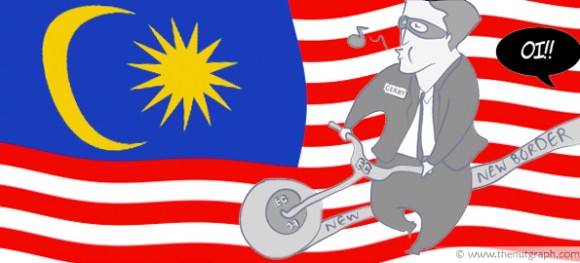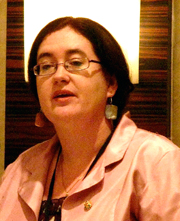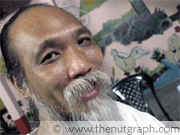SNAP poll next year? Prime Minister Datuk Seri Najib Razak’s popularity rankings are higher than ever before. Some have suggested that the Barisan Nasional (BN) might want the next general election, due only in 2013, called earlier to coincide with the Sarawak state elections which must be held by June 2011.

But there is one reason why BN might not call for an election as early as 2011. And that is because the redrawing of electoral boundaries, an exercise allowed by law not less than eight years after the last one, can at the earliest commence only next year, in 2011. If the analysis that electoral delimitation usually favours the ruling party is true, then BN would want to wait until the exercise was completed, usually in two years.
But if delimitation were to be carried out next year, what patterns can be expected?
Understanding delimitation
The Election Commission (EC) periodically conducts boundary delimitation to allow for population growth. Such an exercise also ensures that the number of voters to one elected representative is roughly equal nationwide. The claim that the exercise benefits the ruling party is based on instances where the BN won in newly-created parliamentary seats, or where blocs of voters were swapped between seats according to race.
The last delimitation exercise was conducted from July 2002 to May 2003, after which Members of Parliament (MPs) approved the creation of 25 new parliamentary seats. Only a simple majority is needed to approve new electoral boundaries the EC proposes. This currently shouldn’t be a problem for the BN with 137 MPs. However, a two-thirds majority to amend Article 46 of the Federal Constitution is required if the number of constituencies is to be increased or decreased.
What were the political circumstances surrounding the last delimitation, and what trends then might influence the next exercise?
In the 2004 elections

Ethnicity has been a common factor in determining new boundaries, not surprisingly because Malaysian political parties are race-based. The 2002-2003 delimitation was influenced by the 1999 general election. Then, Malay Malaysians abandoned Umno in anger over Datuk Seri Anwar Ibrahim’s sacking and first sodomy trial.
With that in mind, the delimitation exercise sought to re-distribute non-Malay voters, who helped the BN survive the 1999 polls, among Malay Malaysian-majority areas. This ensured BN a fighting chance in the 2004 elections. Many analyses credited the “new” factor of then Prime Minister Tun Abdullah Ahmad Badawi for BN’s landslide victory, but other analysts have also questioned the role delimitation played.
In a study on Kedah, political scientists Dr Ong Kian Ming and Dr Bridget Welsh suggest that the 2002-2003 exercise did help BN’s fortunes in 2004. Several adjustments were made to the state’s parliamentary seats after PAS won eight in 1999 when it had none before that. PAS also won an additional eight state seats that year.
“The delimitation process involved moving ‘safe areas’ in traditional Umno strongholds and non-Malay [Malaysian] seats into constituencies that were vulnerable to the opposition… in order to create constituencies that would strengthen the BN’s electoral position,” wrote Ong, now with UCSI University, and Welsh, of the Singapore Management University.

They wrote this in their paper Political Delineation or Guiding Principles? Electoral Delimitation in Kedah 2002 made available to The Nut Graph by Ong. In their study, both observe how an MCA state seat, Gurun, originally in the Kuala Muda parliamentary constituency, was moved to the Jerai parliamentary seat, which was under PAS. BN won Jerai in the 2004 poll. However, PAS managed to reclaim the seat in the historic 2008 elections.
Other examples include the moving of the Kuala Ketil state seat, originally in the MCA-held Padang Serai parliamentary constituency, to the Baling parliamentary seat which was under PAS. Umno won Baling in 2004. Again, however, PAS managed to wrest the seat back in 2008.
Yet another example is the swapping of state seats between the PAS-held Pokok Sena and MCA-won Alor Star parliamentary constituencies. Tanjung Seri in Pokok Sena, a Malay Malaysian-majority seat, was swapped for Derga in Alor Star which had over 50% non-Malay Malaysians. The 2004 results? Both Pokok Sena and Alor Star were won by Umno and MCA respectively. PAS reclaimed Pokok Sena in 2008 while MCA managed to retain Alor Star.
Opposition strongholds left alone
Two states which did not see the creation of new seats in the 2002-2003 delimitation were PAS-led Terengganu and Kelantan, notes political observer Dr Sivamurugan Pandian of Universiti Sains Malaysia.
“The tendency in redrawing boundaries is to leave opposition strongholds alone, and focus on places where the ruling party is at risk but has a fighting chance if a multi-racial mix can be achieved,” he says in a phone interview.
But that was then, based on the 1999 general election results when Chinese Malaysians were stoutly behind BN. They could still be relied on to deliver in 2004, but 2008 has changed that scenario. The next delimitation exercise based on 2008 and the political landscape since then raises interesting challenges for BN if it wants to regain a two-thirds majority.

“Current voting trends as seen in by-elections will likely influence delimitation. Chinese [Malaysian] support in the 1999 and 2004 elections was stable but we might now see the movement of Malay [Malaysian] areas into Chinese [Malaysian] seats to achieve some balance,” Sivamurugan said.
Speculatively, an example might be some kind of transfer from the Pekan to Kuantan parliamentary seats which border each other. In 2008, Najib won in Pekan by more than a 20,000 majority, while Parti Keadilan Rakyat snagged Kuantan by 1,826 votes. The shared border could be redrawn so as to transfer some polling stations from Pekan to Kuantan with the assumption that the transferred voters will continue to support BN come election time. It might mean a decreased majority for BN in Pekan, but that would be a small price to pay if it means regaining Kuantan.
Speculatively again, an example of where delimitation might not be done is in a state like Perlis, where all three parliamentary seats have a Malay Malaysian-majority and were won by BN.
What will be interesting is the new boundaries, if any, in a state like Selangor where BN has six out of 22 parliamentary seats. Two of the six – Sepang and Pandan which have less than 60% Malay Malaysians – are encircled by opposition seats.
Behind closed doors

Malaysia Election Observation Network (MEO-Net) coordinator Ong Boon Keong says the problem with the delimitation process is that it is done behind closed doors. MPs and the public only get to see the proposed new boundaries after the EC presents its finished work in Parliament. The new electoral map is also displayed for public consultation. But Ong notes that not many citizens would bother to scrutinise and object.
“It is also not easy for laypeople to understand electoral maps. When the redrawn boundaries are displayed, there is no comparison with the old boundaries so most people can’t make head or tail of the changes,” he says in a phone interview.
According to Ong, among the best practices in electoral delimitation is in Ohio in the US. The state provides electoral data to citizens and invites them to suggest new boundaries according to, for example, the criteria of maintaining ethnic diversity.
For certain, Malaysia is far from such public consultation. And yet, boundary delimitation has a clear impact on electoral results. Hence, whichever the ruling party, greater checks and balances on the EC, and public engagement are critical if boundary delimitation is to reflect the people’s interest. For now, redrawing electoral boundaries is way too easily approved. ![]()
The Nut Graph needs your support


Malaysian First says
The way I see it. BN will exert its influence by getting state assembly seats in Kedah, Perak and Selangor boundaries changed to their advantage.
In 2008 election, there were quite a number of seats won by Pakatan Rakyat with a few hundred votes majority. These are the ones targeted by BN.
The clearest example how this was done is to “carve” out Malay-majority areas and out of the non-Malay areas. A classic example are the seats of Bandar Tun Razak, Titiwangsa and Wangsa Maju in FT Kuala Lumpur.
A careful observation of the electoral boundaries of Bandar Tun Razak will show that the “opposition areas” neighbouring Bandar Tun Razak/Bandar Permaisuri are “carved” out and lumped with Cheras and Seputeh (that is why the Chinese [Malaysian] voters comprised of more than 90% in these 2 seats).
Similary, the Chinese majority areas of Setapak and Air Panas are mostly taken out of Titiwangsa and Wangsa Maju to give the BN a better chance in these 2 seats.
Just observe closely how some state seats in Kedah, Perak and Selangor that will be ‘re-delineated’ to allow BN advantage in recapturing Kedah and Selangor and ‘retaining’ Perak.
voster says
I volunteer to be the first to express support for a mixed electoral system incorporating some form of proportional representation.
This should, of course, be paired with devolution of powers to lower tiers of governments and local elections, so that the makeup federal MPs will not become the be-all end-all of our politics.
Farouq Omaro says
In Sabah, two state constituencies were created for Muslim-majority Semporna, which are Senallang and Sulabayan. While one Kadazandusun-majority seat was eliminated, which is Langkon. In Lahad Datu, the Kadazandusu-majority area of Ulu Segama was merged with the Tungku consituency, reducing the non-Muslim voter base in Lahad Datu state constituency. In Papar, the number of Kadazandusun-majority seats in the Pantai Manis constituency have been reduced by moving them to the Bongawan constituency! The list goes on and on, and not to mention the number of Bugis and Suluk voters who can easily outnumber local voters in many state and parliamentary constituencies! This is how I see it! If I am wrong, then forgive me.
Malaysian First says
Dear Farouq Omaro,
Very [observant of] you.
If I may also add, during the fourth PM’s time, he realised that if the Kadazan Dusun voters are united and with a bit of help from the Sabahan Chinese, they can easily win the majority of the Sabah state seats and form the state govt. Joseph Pairin Kitingan proved that in 1985/86.
So, the old man was very smart and employed the well-used “divide and rule” strategy from the British. Now you have at least three Kadazan Dusun parties in the so-called Sabah BN but we all know that Umno Sabah calls the shots there.
Therefore, the Kadazan Dusun voters must come together and “force” the existing Kadazan Dusun BN parties to come together and better still join the Opposition just like what Pairin did in the 1990s with Semangat 46.
In order to succeed in Sabah, Pakatan Rakyat must be able to win over at least 50% of both the Kadazan Dusun and Sabahan Chinese’s votes and that is a difficult but not impossible target.